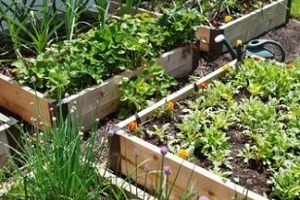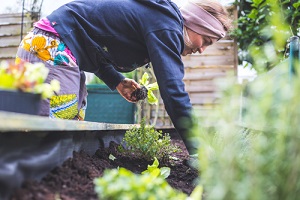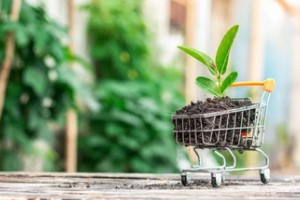 Many people opt to garden using raised beds for a variety of reasons. From the ability to choose the spot in the yard that gets adequate sunlight to facilitating irrigation, there are many points in favor of opting for this gardening model.
Many people opt to garden using raised beds for a variety of reasons. From the ability to choose the spot in the yard that gets adequate sunlight to facilitating irrigation, there are many points in favor of opting for this gardening model.
For many people, however, the main reason to use a raised garden bed is that it gives them the opportunity to use the soil of their choice. For people whose property has challenging types of soil to work with, such as hard-packed soil or clay, as well as those who are concerned about pollutants in their soil, raised garden beds gives them a clean slate from which to work.
However, along with this freedom comes the responsibility to choose the correct type of soil for the project at hand. Here is a look at how you can choose the right soil for a raised garden bed and some other helpful insights about this approach to planting.
What Type Of Soil To Use
Many experts recommend using a high-quality triple mix of soil. This typically means that it contains topsoil, compost, and black loam or peat moss. Another good choice is soil with a 50/50 mix of topsoil and compost.
When shopping for mixed soil, it is important to look for bags bearing terminology such as “organic garden soil for flowers and vegetables” or “organic herb and vegetable mix” to ensure that the soil in question is not contaminated with pesticides.
If you are having soil delivered to your property rather than purchasing bags of soil in person, ask your supplier where the soil comes from. Be wary of topsoil that has been taken from land that is being developed for subdivisions as it could have been sitting for a long time and may be lacking in the nutrients that plants need to survive and thrive.
Amending The Soil
Regardless of the type of soil you choose, take the time to amend it with compost as this will provide it with rich organic matter that gives your plants nutrients and enables it to retain moisture. Raised garden beds can always benefit from compost, regardless of the type of soil used.
If you do not have a compost pile, you can purchase compost from a garden center. You can typically find compost such as shrimp compost, mushroom compost, composted manure and mixes with labels such as “organic vegetable compost.”
As a general guideline, you will want to fill your beds with around 75 percent soil and 25 percent compost. Keep in mind, however, that you will want to continue to amend the soil throughout the gardening season. Therefore, you should plan to keep a compost pile or keep some store-bought compost on reserve.
 For example, if you are pulling out some plants at the midpoint of the season that are no longer producing, it is important to keep in mind that you will be removing some soil with them and the plants you remove will have depleted the soil of nutrients to some degree. Therefore, you will want to top up the beds with compost to reintroduce nutrients and prepare the soil for whatever you are going to plant next.
For example, if you are pulling out some plants at the midpoint of the season that are no longer producing, it is important to keep in mind that you will be removing some soil with them and the plants you remove will have depleted the soil of nutrients to some degree. Therefore, you will want to top up the beds with compost to reintroduce nutrients and prepare the soil for whatever you are going to plant next.
Another time you will need to amend your soil is in the springtime, as the soil levels in raised beds will typically be lower thanks to soil compaction caused by the weight of the snow. Adding some compost can fill them back up to the top.
Some people even add leaves to their soil in the fall. You can run over leaves with a lawnmower to chop them and then sprinkle them into your raised garden beds so they can break down over the winter. You can also put leaves in a compost pile. Keep in mind that adding organic matter to your raised garden bed every year is essential for maintaining its health.
If you have any doubts about the health of the soil in your raised garden bed, consider carrying out a soil pH test to determine which amendments are needed to help your crops thrive. Certain types of plants, such as berries, prefer soil that is more acidic, so you may wish to purchase soil specially formulated for these purposes.
How Much Soil To Buy
Filling raised garden beds often requires more soil than you might think, although the total amount will depend on the size of your garden bed. A good size for a standard rectangular bed is three to four feet wide by six to eight feet across sitting roughly a foot high.
With these dimensions, it will be easy to reach into the bed to plant, sow and weed without needing to walk all the way through it. In fact, one of the big benefits of using a raised garden bed is that it avoids the potential for soil to be compacted over time due to footsteps from walking across it while gardening, which can be a problem with a ground-level garden.
 If your garden beds are big, you might find that soil delivery is more cost-efficient. If this is not possible, however, it is easy to purchase soil and bags from garden centers, and you can use soil calculators online to determine the precise amount of soil that you need.
If your garden beds are big, you might find that soil delivery is more cost-efficient. If this is not possible, however, it is easy to purchase soil and bags from garden centers, and you can use soil calculators online to determine the precise amount of soil that you need.
There is one trick that could reduce the amount of soil you need. If you had to cut sod beneath where you placed your raised bed, simply flip the pieces, putting the grass side down, to fill up the bottom of your raised bed. The soil that is still attached to the grass will break down overtime and this will reduce the amount of soil that you need to fill the bed.
Get In Touch With The Northern Virginia Topsoil Experts
Any time you are setting up raised garden beds, you need to buy the best-quality soil that you can afford for optimum results. The topsoil experts at Dirt Connections can recommend the right type of soil for whatever project you have in mind and deliver it to any location in Northern Virginia. Reach out today to discuss your project.
Summary

Dirt Connections was started with one goal in mind: providing quality residential and commercial construction services to clients on time and on budget. Reach out for more information on how we can support your next project.
For your convenience our estimates are free and by appointment. Call 703-940-9949 for a free estimate today!










































